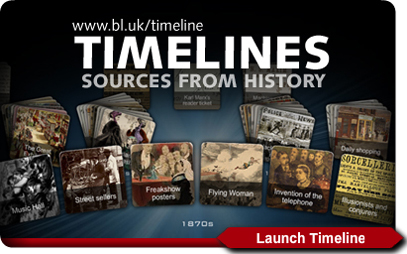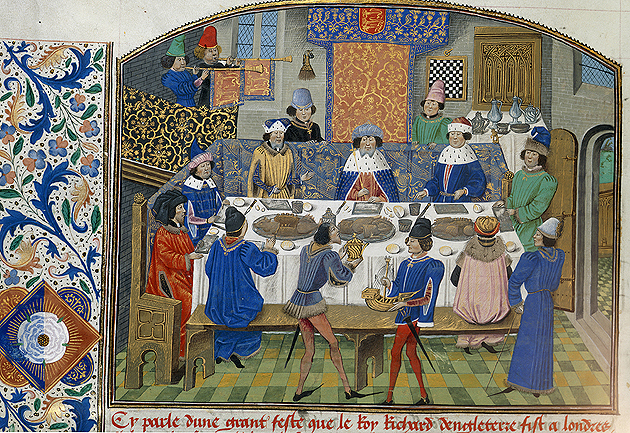Medieval History
Comparing the Peasants' Revolt with the Punk Revolution or medieval astrology with the Apollo moon landings might appear unconnected at first, but the British Library's new interactive website Timelines: Sources from History will allow students to get a sense of change, continuity and chronology when studying historical events. Bringing together material from the Library's vast collections and using cutting-edge technology, users will now be able to discover historical connections and create links in an exciting multimedia experience.

Developed by the Library's Learning team with historians and writers, the timeline includes some of the Library's key collection items from medieval times to the present day such as records of political events, glimpses of everyday life and writings and speeches from some our best known historical and literary figures. Scanning through centuries of images, audio-visual and printed material, users will be able to explore various themed timelines: 'everyday life', 'music and literature' and 'politics, power and rebellion' on one screen.
Highlights of collection items featured include:
 As well as the more well-known collections items, the timeline will also include some of the Library's more unusual sources, opening up a new world of education and learning. Items such as a medieval Valentine's letter (1477); a 15th century recipe for custard (1440); a Renaissance anatomy book (1543); a royal proclamation announcing England's first national lottery (1567); a 17th century dictionary of criminal slang (1674); a newspaper reporting the Great Fire of London (1666); an 18th century guidebook to London prostitutes (1788); a Victorian 'freakshow' poster advertising a 'living mermaid' (1886); and a Make Do and Mend' ration tips pamphlet (1943); these will allow everyone to become an expert as they explore and find fascinating links dating back to 1215.
As well as the more well-known collections items, the timeline will also include some of the Library's more unusual sources, opening up a new world of education and learning. Items such as a medieval Valentine's letter (1477); a 15th century recipe for custard (1440); a Renaissance anatomy book (1543); a royal proclamation announcing England's first national lottery (1567); a 17th century dictionary of criminal slang (1674); a newspaper reporting the Great Fire of London (1666); an 18th century guidebook to London prostitutes (1788); a Victorian 'freakshow' poster advertising a 'living mermaid' (1886); and a Make Do and Mend' ration tips pamphlet (1943); these will allow everyone to become an expert as they explore and find fascinating links dating back to 1215.
Roger Walshe, the British Library's Head of Learning, said: "Finding innovative ways of engaging with the past is increasingly crucial for students and teachers alike. This timeline demonstrates how we can mesh traditional historical sources with new technologies to support future teaching methods, allowing users to engagingly pursue their own research.
Students will be able to trace a variety of stories in one space. For example, an early advert for curry powder from the 18th century reflects the changing tastes of East India Company Workers and reveals tales about the politics, trade, culinary and cultural exchange of that time - a unique insight into life during that period can be gained from one everyday item."
Through the use of innovative Flash programming, users will be able to dig deep into collection items, download information and images, view transcripts, add items to favourites and switch timelines and key events at a click of a button. This will allow for interesting and unique comparisons to be made between various aspects of social, political and cultural life. Users will be able to focus on specific subjects such as political campaigns or technological change or alternatively compare themes within one specific time period - for instance, popular cultural ephemera with items recording political events. Timelines is an ongoing initiative for the British Library and new sources and themes will be added regularly.
Dan Lyndon, Advanced Skills Teacher (History), at Fortismere School, said, "The new Timelines: Sources from History resource from the British Library is a must for all teachers wanting access to their vast archive in a quick and accessible way. The pinwheel navigation allows the user to spin through time at a pace that is manageable making the search for resources straightforward as well as eye-catching. The Library has collected together an array of important and interesting gobbets, neatly combining text and images, and the ability to overlap a variety of themes helps to extend the depth and value of the website."
The British Library's Learning team is a world-leader in providing access to collection items and resources for students and teachers. Using it's award-winning website that attracts 1.2 million visitors every year, the Learning team has consistently developed ways of giving users the chance to explore the Library's collections in a new light. Future developments include major resources to support English Language and Literature study.
Click here to go to Timelines: Lessons from History
- British Library Digitises Greek Manuscripts
The British Library has digitised over a quarter of its Greek manuscripts (284 volumes) for the first time and made them freely available online at www.bl.uk/manuscripts thanks to a generous grant from the Stavros Niarchos Foundation. The website provides...
- Bbc And British Library Look At The History Of Maps
The BBC and the British Library are collaborating on projects that will explore the history of maps going back to the Middle Ages. BBC Four begins by offering two new series: Maps: Power, Plunder and Possession, and The Beauty of Maps. Maps: Power, Plunder...
- Kellie Meyer Reviews Castles: An Anthology
Kellie S. Meyer recently reviewed the British Library's Castles: An Anthology for Medievally Speaking: While Dicken?s Dombey and Son is not one of the books included in Castles: an Anthology, Mrs? Skewton?s medievalist rhapsody may well have been...
- Digitisation Of The Goussen Library
the Goussen library collection is a specialist library for oriental church history. It contains printed books in Western classical and modern languages, but predominantly printed books in oriental languages such as Syrian, Coptic, Ethiopian, Arabic, Armenian...
- Lambeth Library Online
Forwarded by Bob Schacht to the Ecchst List: > ENGLAND: Lambeth Palace library to go online > Posted: Thursday, February 22, 2007 > One of the oldest public libraries in the country is set to go into > cyberspace. The printed book collection of Lambeth...
Medieval History
British Library Launches New Virtual History Timeline
Comparing the Peasants' Revolt with the Punk Revolution or medieval astrology with the Apollo moon landings might appear unconnected at first, but the British Library's new interactive website Timelines: Sources from History will allow students to get a sense of change, continuity and chronology when studying historical events. Bringing together material from the Library's vast collections and using cutting-edge technology, users will now be able to discover historical connections and create links in an exciting multimedia experience.

Developed by the Library's Learning team with historians and writers, the timeline includes some of the Library's key collection items from medieval times to the present day such as records of political events, glimpses of everyday life and writings and speeches from some our best known historical and literary figures. Scanning through centuries of images, audio-visual and printed material, users will be able to explore various themed timelines: 'everyday life', 'music and literature' and 'politics, power and rebellion' on one screen.
Highlights of collection items featured include:
- Records of major events - from the Black Death and the Great Fire to the French Revolution and the abolition of the slave trade.
- Printed matter - the first English printed book, the first cookery manuscript, the first English bible and the first postage stamp.
- Public Life - posters, advertisements and illustrations documenting everything from public executions and magic shows to plague cures and séances.
- Campaigns - pamphlets and writings from activists such as Abolitionists, Chartists, Communists and CND marchers.
- Manuscripts - written by great figures in history including Henry VIII, Elizabeth I, Captain Cook, Beethoven, Wordsworth, Abolitionists, Florence Nightingale and Dickens.
- Maps - cities, military campaigns and imagined lands.
- Patents - including those for the Spinning Jenny, the bicycle and the machine gun.

Roger Walshe, the British Library's Head of Learning, said: "Finding innovative ways of engaging with the past is increasingly crucial for students and teachers alike. This timeline demonstrates how we can mesh traditional historical sources with new technologies to support future teaching methods, allowing users to engagingly pursue their own research.
Students will be able to trace a variety of stories in one space. For example, an early advert for curry powder from the 18th century reflects the changing tastes of East India Company Workers and reveals tales about the politics, trade, culinary and cultural exchange of that time - a unique insight into life during that period can be gained from one everyday item."
Through the use of innovative Flash programming, users will be able to dig deep into collection items, download information and images, view transcripts, add items to favourites and switch timelines and key events at a click of a button. This will allow for interesting and unique comparisons to be made between various aspects of social, political and cultural life. Users will be able to focus on specific subjects such as political campaigns or technological change or alternatively compare themes within one specific time period - for instance, popular cultural ephemera with items recording political events. Timelines is an ongoing initiative for the British Library and new sources and themes will be added regularly.
Dan Lyndon, Advanced Skills Teacher (History), at Fortismere School, said, "The new Timelines: Sources from History resource from the British Library is a must for all teachers wanting access to their vast archive in a quick and accessible way. The pinwheel navigation allows the user to spin through time at a pace that is manageable making the search for resources straightforward as well as eye-catching. The Library has collected together an array of important and interesting gobbets, neatly combining text and images, and the ability to overlap a variety of themes helps to extend the depth and value of the website."
The British Library's Learning team is a world-leader in providing access to collection items and resources for students and teachers. Using it's award-winning website that attracts 1.2 million visitors every year, the Learning team has consistently developed ways of giving users the chance to explore the Library's collections in a new light. Future developments include major resources to support English Language and Literature study.
Click here to go to Timelines: Lessons from History
- British Library Digitises Greek Manuscripts
The British Library has digitised over a quarter of its Greek manuscripts (284 volumes) for the first time and made them freely available online at www.bl.uk/manuscripts thanks to a generous grant from the Stavros Niarchos Foundation. The website provides...
- Bbc And British Library Look At The History Of Maps
The BBC and the British Library are collaborating on projects that will explore the history of maps going back to the Middle Ages. BBC Four begins by offering two new series: Maps: Power, Plunder and Possession, and The Beauty of Maps. Maps: Power, Plunder...
- Kellie Meyer Reviews Castles: An Anthology
Kellie S. Meyer recently reviewed the British Library's Castles: An Anthology for Medievally Speaking: While Dicken?s Dombey and Son is not one of the books included in Castles: an Anthology, Mrs? Skewton?s medievalist rhapsody may well have been...
- Digitisation Of The Goussen Library
the Goussen library collection is a specialist library for oriental church history. It contains printed books in Western classical and modern languages, but predominantly printed books in oriental languages such as Syrian, Coptic, Ethiopian, Arabic, Armenian...
- Lambeth Library Online
Forwarded by Bob Schacht to the Ecchst List: > ENGLAND: Lambeth Palace library to go online > Posted: Thursday, February 22, 2007 > One of the oldest public libraries in the country is set to go into > cyberspace. The printed book collection of Lambeth...
